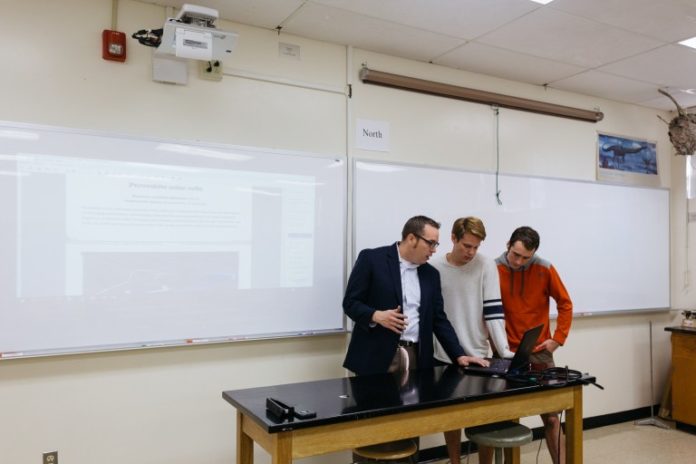Dr. Nathan Tice, Assistant Professor of Chemistry at the University of Findlay, visited Grace College’s Organic Chemistry I class on Friday, Oct. 7.
Dr. Chad Snyder, Associate Professor of Chemistry at Grace, invited Dr. Tice to give a seminar to his students about green chemistry, alternative energy and summer research opportunities for Grace College science students.
Dr. Snyder and Dr. Tice are currently involved in a semiconductor/alternative energy research project with students at Grace College. Both professors seek to provide novel organic compounds that can serve as low-cost, low-energy substitutes for liquid-crystal displays. This technology is found in most flatscreen devices. Grace students Grant Carlson, Austin Steppey and Micah Gerakinis work in Dr. Snyder’s Synthetic Organic Research Laboratory synthesizing compounds that are then sent to Dr. Tice for spectroscopic analysis. In turn, Dr. Tice provides Grace College the analytical confirmation required for publication and for proceeding forward in their findings.
Carlson, Steppey and Gerakinis plan to present their latest findings at the 132nd-annual meeting of the Indiana Academy of Science scheduled for March, 2017. Grace College and the University of Findlay will present their collaborative work in an oral and poster session in this state-wide meeting. Both research groups, Drs. Snyder and Tice have targeted federal funding through the National Science Foundation in order to further this research, widen its scope, obtain research equipment and fund its students. They plan to send Grace College and University of Findlay undergraduate research students to an American Chemical Society Meeting to present their work on a national level. The American Chemical Society has nearly 157,000 members and is the world’s largest scientific society and one of the world’s leading sources of authoritative scientific information.
Dr. Snyder and Dr. Tice have collaborated on several projects over the last 11 years and have published papers in journals including “The Journal of Organic Chemistry,” “The Journal of Organometallic Chemistry,” “Transition Metal Chemistry” and “The Journal of Sulfur Chemistry.” Undergraduate research students served as coauthors on these peer-reviewed manuscripts.





